List of people who have walked on the Moon
Twelve people have walked on Earth's Moon, starting with Neil Armstrong and ending with Gene Cernan. All crewed lunar landings took place between July 1969 and December 1972 as part of the United States Apollo program. All twelve people who have walked on the Moon are American men.

Alan Shepard was the oldest person to walk on the Moon, at age 47 years and 80 days. Charles Duke was the youngest, at age 36 years and 201 days. Duke, Buzz Aldrin, David Scott, and Harrison Schmitt are still living as of 8 May 2020; the most recent to die was Alan Bean.[2]
Moonwalkers
Twelve people have walked on the Moon. Four of them are still living as of 7 April 2020. All crewed lunar landings took place between July 1969 and December 1972 as part of the Apollo program. Most astronauts at that time came from the military services and were considered to be on active duty during their NASA service; the few exceptions were considered civilian NASA astronauts (regardless of any prior military service).
| Image | No. | Name | Mission | Born | Died | Lunar EVA dates (UTC)[3] | Lunar EVAs[3] | Total EVA duration[3] | Astronaut service |
|---|---|---|---|---|---|---|---|---|---|
 |
1. | Neil Armstrong | Apollo 11 | August 5, 1930[4] | August 25, 2012 (aged 82) | July 21, 1969[lower-alpha 1] | 1 | 2 hours 31 minutes | NASA[lower-alpha 2] |
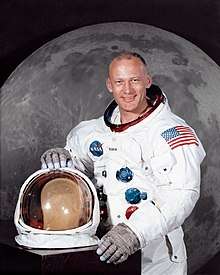 |
2. | Buzz Aldrin | Apollo 11 | January 20, 1930[5] | July 21, 1969[lower-alpha 1] | 1 | 2 hours 31 minutes | Air Force | |
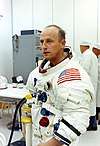 |
3. | Charles "Pete" Conrad | Apollo 12 | June 2, 1930[6] | July 8, 1999 (aged 69) | November 19–20, 1969 | 2 | 7 hours 45 minutes | Navy |
.jpg) |
4. | Alan Bean | Apollo 12 | March 15, 1932[7] | May 26, 2018 (aged 86) | November 19–20, 1969 | 2 | 7 hours 45 minutes | Navy |
.jpg) |
5. | Alan Shepard | Apollo 14 | November 18, 1923[8] | July 21, 1998 (aged 74) | February 5–6, 1971 | 2 | 9 hours 21 minutes | Navy |
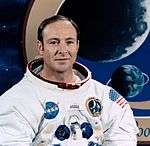 |
6. | Edgar Mitchell | Apollo 14 | September 17, 1930[9] | February 4, 2016 (aged 85) | February 5–6, 1971 | 2 | 9 hours 21 minutes | Navy |
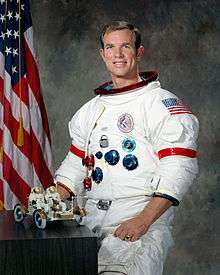 |
7. | David Scott | Apollo 15 | June 6, 1932[10] | July 31–August 2, 1971 | 3 | 18 hours 33 minutes | Air Force | |
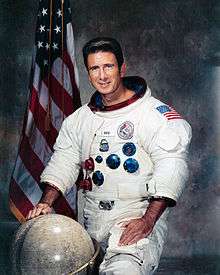 |
8. | James Irwin | Apollo 15 | March 17, 1930[11] | September 8, 1991 (aged 61) | July 31–August 2, 1971 | 3 | 18 hours 33 minutes | Air Force |
.jpg) |
9. | John Young | Apollo 16 | September 24, 1930[12] | January 5, 2018 (aged 87) | April 21–23, 1972 | 3 | 20 hours 14 minutes | Navy |
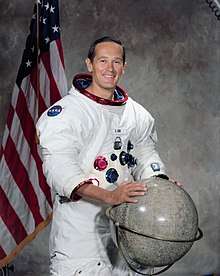 |
10. | Charles Duke | Apollo 16 | October 3, 1935[13] | April 21–23, 1972 | 3 | 20 hours 14 minutes | Air Force | |
 |
11.[lower-alpha 3] | Gene Cernan | Apollo 17 | March 14, 1934[14] | January 16, 2017 (aged 82) | December 11–14, 1972 | 3 | 22 hours 2 minutes | Navy |
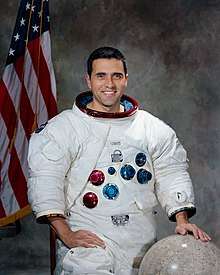 |
12. | Harrison Schmitt | Apollo 17 | July 3, 1935[15] | December 11–14, 1972 | 3 | 22 hours 2 minutes | NASA | |
- Americans alive at the time remember it as the night of July 20, 1969 (Armstrong set foot on the Moon at 10:56 p.m. Eastern Daylight Time), but it was the 21st in UTC.
- Armstrong had left the US Navy and was already a NASA employee when he and Elliot See became the first civilian astronauts in Astronaut Group 2. See Armstrong's NASA biography and a description of his receiving a NASA award, among others.
- Gene Cernan is known as the person to have most recently walked on the Moon. This list illustrates the first person to egress on each mission. Cernan was the first to egress but was the last person back in the lunar module, so he was the 11th to walk on the Moon and the most recent to have walked on it.
Potential moonwalkers
Jim Lovell and Fred Haise were scheduled to walk on the Moon during the Apollo 13 mission, but the lunar landing was aborted following a major malfunction en route to the Moon.[16] Haise was again scheduled to walk on the Moon as commander of Apollo 19, but Apollo 18 and Apollo 19 were canceled on September 2, 1970.
NASA announced in July 2019 plans for another man and the first woman to walk on the Moon during Artemis 3 in 2024.[17][18]
Lunar activities
Armstrong descended the lunar module ladder and spoke his famous epigram, "That's one small step for [a] man, one giant leap for mankind."[19] He then went to work on collecting the contingency sample, which was a scoop of the lunar surface collected early in the mission in case there was an emergency.[20] Armstrong took the TV camera off the lunar module and mounted it to a tripod.[21] After that, Aldrin descended the ladder to join Armstrong.[22] Aldrin egressed to the surface about nine minutes after Armstrong.[23] They had some trouble planting the American flag into the lunar soil, but were able to secure it into the surface. Aldrin positioned himself in front of a video camera and began experimenting with different locomotion techniques on the surface.[24] During these experiments, Armstrong and Aldrin received a phone call from President Nixon, congratulating them for the successful landing.[25]
Aldrin then set to work documenting the condition of the spacecraft to ensure it was in proper condition for their upcoming launch. After setting up a couple of experiments with Armstrong, Aldrin went to work hammering a tube into the lunar surface to obtain a core sample.[26] Aldrin's EVA ended when they loaded the lunar samples into the spacecraft and tossed out unneeded items, just before sealing the hatch.[21] Armstrong performed the majority of the photography on the surface, which is why there are only five photos of him on the Moon.[27]
Soon after piloting the LM Falcon to a landing at Hadley Rille, Scott accomplished the only stand-up EVA through the lander's top hatch, using it as a high place from which to refine the geology traverses he and Irwin would undertake during the following days. Scott became the first to drive a vehicle on the Moon as he drove the Lunar Roving Vehicle, more than doubling Apollo 14's EVA time. After the final traverse, back outside the LM, Scott performed a demonstration of Galileo's theory that all objects fall at the same rate in vacuum by dropping a hammer and a feather for the television camera.
Irwin came onto the lunar surface soon after his commander, Scott. As the LRV's first passenger, he had an often rough ride as Scott swerved to avoid craters.[28] It was Irwin who, during the second EVA, first spotted the Genesis Rock and aided Scott in collecting this bit of the early lunar crust.[29] A man of deep Christian religious faith, Irwin quoted from Psalms while on the lunar surface and later became an evangelist.[30]
See also
Notes
- Chaikin 2007, pp. 597–607.
- Mancini, John (May 26, 2018). "Now just four men who walked on the moon are still alive". Quartz. Retrieved March 5, 2019.
- Chaikin 2007, pp. 611–613.
- Hansen 2012, pp. 49–50.
- "To the Moon and beyond". The Record (Bergen County). July 20, 2009. Archived from the original on May 16, 2011. Retrieved July 20, 2009.
- "New Astronauts, 9 Hottest Jet Pilots in U.S., Have Been Training a Year". The Philadelphia Enquirer. Philadelphia, Pennsylvania. September 18, 1962. p. 3 – via Newspapers.com.
- Jacobs, Nancy (November 14, 1969). "Ex-Coleman Resident Bean to be 4th on Moon". Abilene Reporter-News. Abilene, Texas. p. 2 – via Newspapers.com.
- Thompson 2004, p. 7.
- "Mitchell, Once a Cowpoke, is an Intellectual". The Evening Sun. Baltimore, Maryland. New York Times News Service. February 1, 1971 – via Newspapers.com.
- Furlong, William Barry (February 27, 1969). "Flying is in Astronaut's Blood". Quad-City Times. Davenport, Iowa. World Book Science Service. p. 29 – via Newspapers.com.
- "A Who's Who on Apollo Crew". Daily News. New York, New York. July 26, 1971. p. 12 – via Newspapers.com.
- "Astronauts Could Have a Party". The Orlando Sentinel. Orlando, Florida. February 3, 1963. p. 15 – via Newspapers.com.
- Chaikin 2007, p. 600.
- "Astronauts are Like Two Peas from a Pod". The Miami News. Miami, Florida. June 3, 1966. p. 10 – via Newspapers.com.
- "Schmitt One Of Those Who Has Been There". Alamogordo Daily News. Alamogordo, New Mexico. October 16, 1977. p. 10 – via Newspapers.com.
- Tate, Karl (April 13, 2015). "How Apollo 13's Dangerous Survival Mission Worked (Infographic)". Space.com. Retrieved February 21, 2019.
- "NASA outlines plans for lunar lander development through commercial partnerships". 21 July 2019.
- "NASA unveils schedule for 'Artemis' 2024 Moon mission". France24. 23 May 2019. Retrieved 21 July 2019.
- Mikkelson, Barbara; Mikkelson, David (October 2006). "One Small Misstep: Neil Armstrong's First Words on the Moon". Snopes.com. Retrieved September 19, 2009.
- Meyer, Charles (2009). "Lunar Sample Compendium: Contingency Soil (10010)" (PDF). Astromaterials Research & Exploration Science. NASA. Retrieved June 13, 2013.
- Jones, Eric M.; Glover, Ken, eds. (1995). "First Steps". Apollo 11 Lunar Surface Journal. NASA. Retrieved September 23, 2006.
- Jones, Eric M., ed. (1995). "One Small Step". Apollo 11 Lunar Surface Journal. NASA. Retrieved June 13, 2013.
- Orloff 2000, pp. 102–110.
- Chaikin 2007, pp. 212–213.
- Chaikin 2007, p. 215.
- Chaikin 2007, pp. 216–217.
- Jones, Eric M. (July 28, 2011). "AS11-40-5886". Apollo 11 Lunar Surface Journal. NASA. Archived from the original on July 28, 2011. Retrieved May 13, 2011.
- Chaikin 2007, pp. 417–418.
- Chaikin 2007, pp. 430–431.
- Chaikin 2007, pp. 437, 442, 557–558.
References
- Chaikin, Andrew (2007) [1994]. A Man on the Moon: The Voyages of the Apollo Astronauts. London: Penguin Books. ISBN 978-0-14-311235-8. OCLC 958200469.CS1 maint: ref=harv (link)
- Hansen, James R. (2012). First Man: The Life of Neil A. Armstrong. New York: Simon & Schuster. ISBN 978-1-4767-2781-3. OCLC 1029741947.CS1 maint: ref=harv (link)
- Orloff, Richard W. (2000). Apollo by the Numbers: A Statistical Reference. NASA History Series. Washington, DC: NASA History Division, Office of Policy and Plans. ISBN 978-0-16-050631-4. LCCN 00061677. OCLC 829406439. NASA SP-2000-4029. Retrieved June 12, 2013.CS1 maint: ref=harv (link)
- Thompson, Neal (2004). Light This Candle: The Life & Times of Alan Shepard, America's First Spaceman (1st ed.). New York: Crown Publishers. ISBN 0-609-61001-5. LCCN 2003015688. OCLC 52631310.CS1 maint: ref=harv (link)
